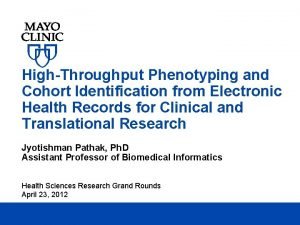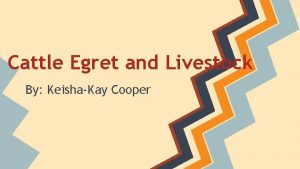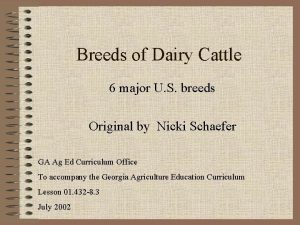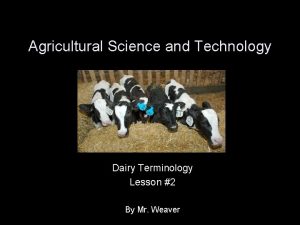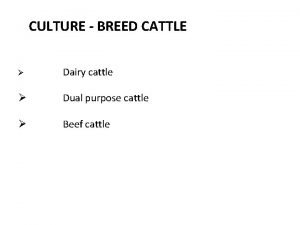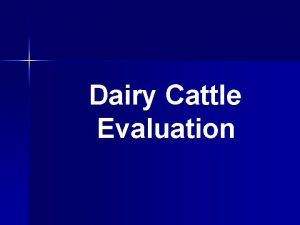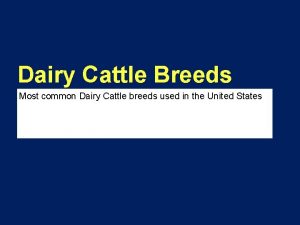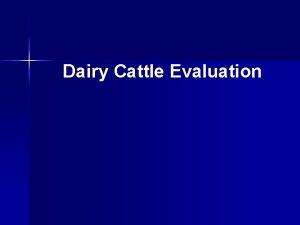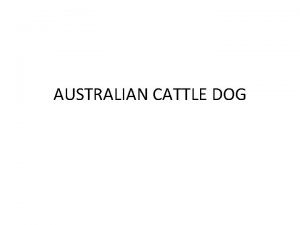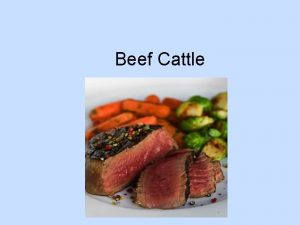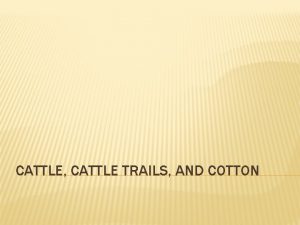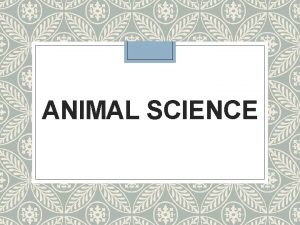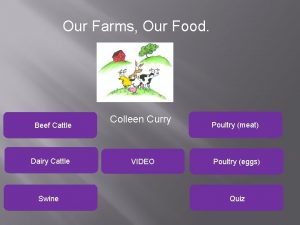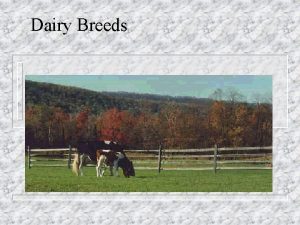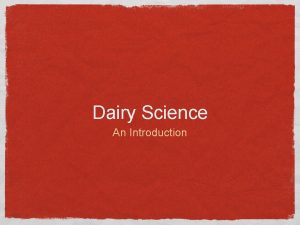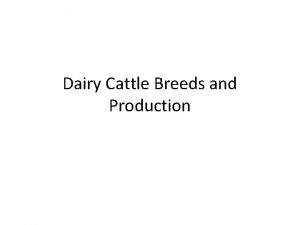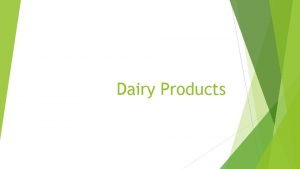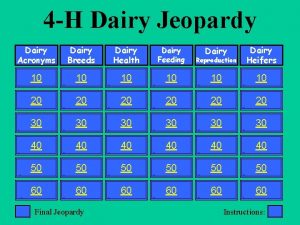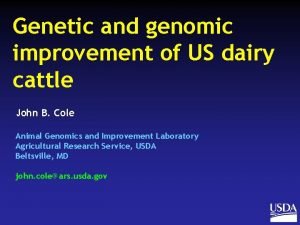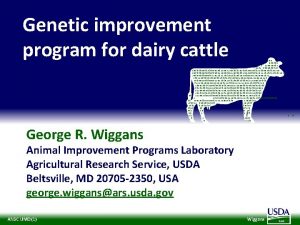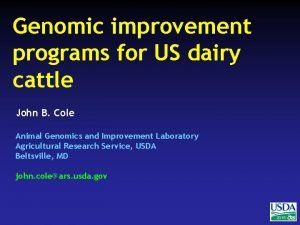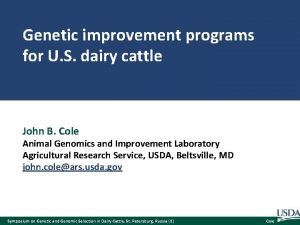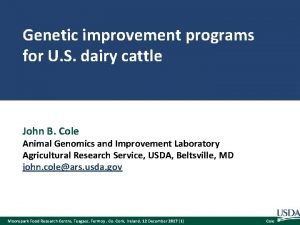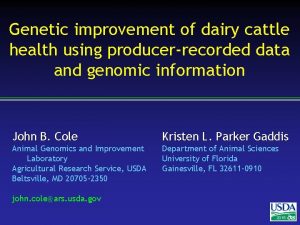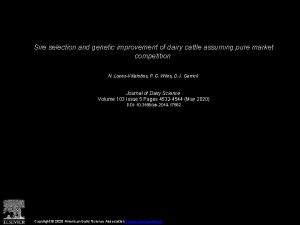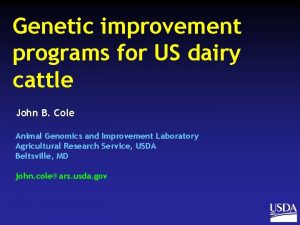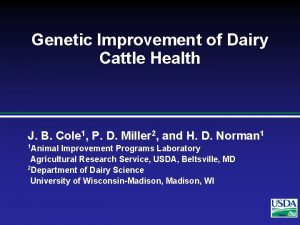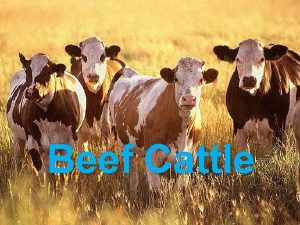The role of phenotyping in dairy cattle improvement















































- Slides: 47

The role of phenotyping in dairy cattle improvement in the genomic era John B. Cole Animal Genomics and Improvement Laboratory Agricultural Research Service, USDA Beltsville, MD john. cole@ars. usda. gov

Well, here we are Department of Dairy Science, University of Wisconsin, Madison, May 5, 2016 (‹#›) Cole

What is a phenotype? • Any characteristic or property of an animal that we can observe and measure • Early selection probably was based on coat color and pattern • Later, milk and butterfat were used • Now, we measure many things Department of Dairy Science, University of Wisconsin, Madison, May 5, 2016 (‹#›) Cole

What do we routinely measure today? Trait Yield (milk, fat, protein) Productive life Somatic cell score Heritability (%) 25 -40 8. 5 12 Daughter pregnancy rate 4 Heifer conception rate Cow conception rate Conformation (type) (~18 traits) Sire (direct) calving ease Daughter (maternal) calving ease Sire (direct) stillbirth Daughter (maternal) stillbirth Department of Dairy Science, University of Wisconsin, Madison, May 5, 2016 (‹#›) 1 1. 6 7 -54 8. 6 3. 0 6. 5 Cole

Why do scientists measure things? • Because we can? • “That’s funny. . . ” are the most interesting words in science • To better understand a phenomenon • How does it work? • Is it predictable? • Can we change it? • My advisor told me to do it, and I want to graduate Department of Dairy Science, University of Wisconsin, Madison, May 5, 2016 (‹#›) Cole

Why do farmers measure things? • In order to make better decisions • There must be perceived value • Not everyone agrees on value (e. g. , animal ID) • There’s a direct financial incentive • e. g. , progeny test herds • Because scientists ask them to • There may be narrow limits on what farmers will do out of altruism Department of Dairy Science, University of Wisconsin, Madison, May 5, 2016 (‹#›) Cole

Sources of new phenotypes Barn: flooring type, bedding materials, density, weather data Cow: body temperature, activity, rumination time, feed & water intake Herdsmen/consultants: health events, foot/claw health, veterinary treatments Parlor: yield, composition, milking speed, conductivity, progesterone, temperature Silo/bunker: ration composition, nutrient profiles Pasture: soil type/composition, nutrient composition http: //commons. wikimedia. org/wiki/File: Amish_dairy_farm_3. jpg Department of Dairy Science, University of Wisconsin, Madison, May 5, 2016 (‹#›) Cole

What influences a phenotype? P=G+E The percentage of total variation attributable to genetics is small. • CA$: 0. 07 • DPR: 0. 04 • PL: 0. 08 • SCS: 0. 12 The percentage of total variation attributable to environmental factors is large: • Feeding/nutrition • Housing • Reproductive management Department of Dairy Science, University of Wisconsin, Madison, May 5, 2016 (‹#›) Cole

Mendel wanted to understand Source: https: //adapaproject. org/bbk_temp/tiki-index. php? page=Leaf%3 A+Who+was+Gregor+Mendel%3 F. Department of Dairy Science, University of Wisconsin, Madison, May 5, 2016 (‹#›) Cole

Department of Dairy Science, University of Wisconsin, Madison, May 5, 2016 (‹#›) Cole

Morgan et al. said “that’s interesting. . . ” Source: http: //dev. biologists. org/content/139/15/2821. Department of Dairy Science, University of Wisconsin, Madison, May 5, 2016 (‹#›) Cole

Great diversity in livestock species • There is tremendous phenotypic variation among livestock species Source: ARS. • Several contributing mechanisms (Andersson, 2013, doi: 10. 1016/j. gde. 2013. 02. 014) • Directional selection for adaptive mutations • Directional selection for phenotypic apperance • Natural selection for human environment • Genetic drift Department of Dairy Science, University of Wisconsin, Madison, May 5, 2016 (‹#›) Cole

Mendelian recessives are not unusual Name Chrome Location (Mbp) Freq of minor haplotype Gene Name HH 1 5 63. 15 1. 92 APAF 1 HH 2 1 94. 8 to 96. 6 1. 66 unknown HH 3 8 95. 41 2. 95 SMC 2 HH 4 1 1. 27 0. 37 GART HH 5 9 93. 2 to 93. 3 2. 22 TFB 1 M JH 1 15 15. 70 12. 10 CWC 15 JH 2 26 8. 81 to 9. 41 1. 3 unknown BH 1 7 42. 8 to 47. 0 6. 67 unknown BH 2 19 11. 1 7. 78 TUBD 1 AH 1 17 65. 92 13. 0 UBE 3 B For a complete list, see: http: //aipl. arsusda. gov/reference/recessive_haplotypes_ARR-G 3. html. Department of Dairy Science, University of Wisconsin, Madison, May 5, 2016 (‹#›) Cole

Many genes affect quantitative traits Source: Council on Dairy Cattle Breeding (https: //www. cdcb. us/Report_Data/Marker_Effects/marker_effects. cfm? Breed=HO&Trait=SCS). Cole Department of Dairy Science, University of Wisconsin, Madison, May 5, 2016 (‹#›)

Pleiotropy is not unusual Source: Cole et al. , 2014 (https: //asas. org/docs/default-source/wcgalpproceedings-oral/304_paper_10265_manuscript_1272_0. pdf). Cole Department of Dairy Science, University of Wisconsin, Madison, May 5, 2016 (‹#›)

How do we choose what to measure? • Opportunity • The phenotype is easily measured using available labor and materials • Necessity • The measurement is needed to solve a problem • Novelty • Most of us like to work on new problems Department of Dairy Science, University of Wisconsin, Madison, May 5, 2016 (‹#›) Cole

How carefully should we measure? • Precise definitions are important (e. g. , Seidenspinner et al. , 2009). . . • . . . except when they’re not (Waurich et al. , 2011) • How many values do discrete scales really need? • Beware false precision on continuous scales! • Remember P = G + E! Department of Dairy Science, University of Wisconsin, Madison, May 5, 2016 (‹#›) Cole

Are we talking about the same thing? • What do commonly used terms mean? • “Efficiency”, “health”, “sustainability”, “welfare” • Unlike things may be conflated • “Lameness” versus “locomotion” • Some formats can support general as well as detailed reports • e. g. , AGIL Format 6 Department of Dairy Science, University of Wisconsin, Madison, May 5, 2016 (‹#›) Cole

Context matters • Information often lacking about environments in which phenotypes are expressed • Where? When? How? • Qualitative versus quantitative descriptions • Phenotypes often change over time • Sometimes desirable, sometimes not • Who records the phenotypes? Department of Dairy Science, University of Wisconsin, Madison, May 5, 2016 (‹#›) Cole

Selection indices include many traits… Australia - APR Belgium (Walloon) - V€G Canada - LPI France - ISU Germany - RZG Great Britain - PLI Ireland - EBI Protein (kg) Israel - PD 11 Fat (kg) Milk (kg) Italy - PFT Type Japan - NTP Longevity Netherlands - NVI Udder Health New Zealand - BW Fertility Others Nordic Countries - TMI South Africa - BVI Spain - ICO Switzerland - ISEL United States - NM$ United States - TPI 0% 10% 20% 30% 40% 50% 60% 70% 80% 90% 100% Source: Miglior et al. (2012) Department of Dairy Science, University of Wisconsin, Madison, May 5, 2016 (‹#›) Cole

…and we keep adding more Relative emphasis on traits in index (%) PD$ Trait 1971 Milk 52 Fat 48 Protein … PL … SCS … UDC … FLC … BDC … DPR … HCR … CCR … SCE … DCE … CA$ … MFP$ 1976 27 46 27 … … … CY$ 1984 – 2 45 53 … … … NM$ 1994 6 25 43 20 – 6 … … … … … NM$ 2000 5 21 36 14 – 9 7 4 – 4 … … … NM$ 2003 0 22 33 11 – 9 7 4 – 3 7 … … – 2 … NM$ 2006 0 23 23 17 – 9 6 3 – 4 9 … … 6 NM$ 2010 2014 0 -1 19 22 16 20 22 19 – 10 -7 7 8 4 3 – 6 -5 11 7 … 2 … 1 … … 5 5 Source: AGIL, ARS, USDA (http: //aipl. arsusda. gov/reference/nmcalc-2014. htm). Department of Dairy Science, University of Wisconsin, Madison, May 5, 2016 (‹#›) Cole

Some recent new dairy phenotypes • Claw health (Van der Linde et al. , 2010) • Dairy cow health (Parker Gaddis et al. , 2013) • Embryonic development • Immune response (Cochran et al. , 2013) (Thompson-Crispi et al. , 2013) • Methane production (de Haas et al. , 2011) • Milk fatty acids (Soyeurt et al. , 2011) • Persistency of lactation • Rectal temperature (Cole et al. , 2009) (Dikmen et al. , 2013) • Residual feed intake (Connor et al. , 2013) Department of Dairy Science, University of Wisconsin, Madison, May 5, 2016 (‹#›) Cole

When is enough? 505 phenotypes! Source: Cattle. QTLdb: http: //www. animalgenome. org/cgi-bin/QTLdb/BT/summary. Department of Dairy Science, University of Wisconsin, Madison, May 5, 2016 (‹#›) Cole

Digression – How many QTL, did you say? If there really are 1, 148 calving ease QTL, then: • What really *is* a QTL? • Is Bayes B actually so objectionable after all? • What should we really be selecting for? Department of Dairy Science, University of Wisconsin, Madison, May 5, 2016 (‹#›) Cole

Making sense of 505 cattle traits • Ontologies organize traits by their meaning and relationship(s) to one another • Hughes et al. (2008) reported on the Animal Trait Ontology project • The Livestock Product Trait Ontology includes 473 terms • Who uses these structures? • Should ontology IDs be used to identify phenotypes in manuscripts? Department of Dairy Science, University of Wisconsin, Madison, May 5, 2016 (‹#›) Cole

Example ontology: milk SCC Source: Livestock Production Trait Ontology (http: //www. animalgenome. org/cgi-bin/amido/termdetails. cgi? term=LPT: 0010379&session_id=9913 amigo 1461982176). Department of Dairy Science, University of Wisconsin, Madison, May 5, 2016 (‹#›) Cole

Who gets to define phenotypes? • Anyone willing to take the time? • Just because you define it does not mean people will use it • International standards bodies • ICAR Working Group on Functional Traits • Are we comfortable with proprietary phenotypes? • Does it matter? Department of Dairy Science, University of Wisconsin, Madison, May 5, 2016 (‹#›) Cole

Formal definitions exist for recessives Source: OMIA 001697 -9913 : Abortion due to haplotype JH 1 in Bos taurus (http: //omia. angis. org. au/OMIA 1697/9913/). Department of Dairy Science, University of Wisconsin, Madison, May 5, 2016 (‹#›) Cole

Why do we need new traits? • Changes in production economics This is a fancy way • Better of understanding biology sayingof that • Recent review by Egger-Danner et al. selection objectives change! • Technology produces new phenotypes Department of Dairy Science, University of Wisconsin, Madison, May 5, 2016 (‹#›) Cole

What do current phenotypes look like? Low-dimensionality Usually few observations per lactation Close correspondence of phenotypes with values measured Easy transmission and storage Department of Dairy Science, University of Wisconsin, Madison, May 5, 2016 (‹#›) Cole

What do new phenotypes look like? High dimensionality Ex. : MIR produces 1, 060 points/obs. Disconnect between phenotype and measurement More resources needed for transmission, storage, and analysis Department of Dairy Science, University of Wisconsin, Madison, May 5, 2016 (‹#›) Cole

Phenotypic correlation with existing traits high low New traits should add information Novel phenotypes include some new information Novel phenotypes contain little new information Novel phenotypes include much new information Novel phenotypes contain some new information low high Genetic correlation with existing traits Department of Dairy Science, University of Wisconsin, Madison, May 5, 2016 (‹#›) Cole

Value of phenotype high low New traits should have value (milk yield) (feed intake) (conformation) (greenhouse gas emissions) low high Cost of measurement Department of Dairy Science, University of Wisconsin, Madison, May 5, 2016 (‹#›) Cole

Does “P” matter in the genomics era? • An animal’s genotype is good for all traits • Traditional evaluations are required for accurate estimates of SNP effects… • …but evaluations are not currently available for many new traits, e. g. , feed efficiency • Research populations could provide data for traits that are expensive to measure • Will resulting evaluations work in target population? Department of Dairy Science, University of Wisconsin, Madison, May 5, 2016 (‹#›) Cole

Genotypes are abundant 800000 Imputed, Young Imputed, Old 700000 <50 k, Young, Female <50 k, Young, Male <50 k, Old, Female Number of Genotypes 600000 <50 k, Old, Male 50 k, Young, Female 50 k, Young, Male 500000 50 k, Old, Female 50 k, Old, Male 400000 300000 200000 100000 90 4 90 8 10 01 10 04 10 06 10 08 10 10 10 12 11 04 11 06 11 08 11 10 11 12 12 04 12 06 12 08 12 10 12 12 13 04 13 06 13 08 13 10 13 12 14 04 14 06 14 08 14 10 14 12 15 02 0 Run Date Department of Dairy Science, University of Wisconsin, Madison, May 5, 2016 (‹#›) Cole

What’s a SNP genotype worth? Pedigree is equivalent to information on about 7 daughters For the protein yield (h 2=0. 30), the SNP genotype provides information equivalent to an additional 34 daughters Department of Dairy Science, University of Wisconsin, Madison, May 5, 2016 (‹#›) Cole

What’s a SNP genotype worth? And for daughter pregnancy rate (h 2=0. 04), SNP = 131 daughters Department of Dairy Science, University of Wisconsin, Madison, May 5, 2016 (‹#›) Cole

We can construct P from G • Predict from correlated traits or phenotypes from reference herds • Causal variants can be used in place of markers • Haplotypes can be used when causal variants are not known • Specific combining abilities can combine additive and dominance effects (e. g. , Sun et al. , 2014) Department of Dairy Science, University of Wisconsin, Madison, May 5, 2016 (‹#›) Cole

What do we do with new traits? • Put them into a selection index • Correlated traits are helpful • Apply selection for a long time • There are no shortcuts • Collect many phenotypes • Repeated records of limited value • Genomics can increase accuracy • Weigh cost versus benefit Department of Dairy Science, University of Wisconsin, Madison, May 5, 2016 (‹#›) Cole

What challenges are on the horizon? We need more frequent sampling for modern management Samples do not need to be evenly spaced across the lactation Some large farms do not see a value proposition in milk recording On-farm data are growing, but not collected in a central database Department of Dairy Science, University of Wisconsin, Madison, May 5, 2016 (‹#›) Cole

Has our DHI system fallen behind? • Research is being done on new traits • Often not turned into new products • It’s a collective action problem • Disagreement on objectives • Lack of commercial incentives • Infrastructure is not in place • This provides an opportunity for new players to enter the market Department of Dairy Science, University of Wisconsin, Madison, May 5, 2016 (‹#›) Cole

How do new players fit into the system? • How do we deal with data collected outside of the DHI system? • QC guidelines • Standards for data analysis • Is lack of independent validation a problem? • How do we combine data from old and new data providers? • Unified national evaluations? Department of Dairy Science, University of Wisconsin, Madison, May 5, 2016 (‹#›) Cole

No guarantees with new technologies • New technologies often require considerable capital investment • They sometimes fail to work or do not deliver the promised gain • Data are most useful when combined with observations from many farms • This inevitably involves risk Department of Dairy Science, University of Wisconsin, Madison, May 5, 2016 (‹#›) Cole

Collaboration is essential • When new traits are expensive, it takes a consortium to collect the data needed for genetic evaluation. Department of Dairy Science, University of Wisconsin, Madison, May 5, 2016 (‹#›) Cole

Preservation of unique resources • Many unique resources have been lost (e. g. , selection experiments) • We need to preserve phenotypes as well as genotypes • Whose job is this? • Perhaps ARS’s National Center for Genetic Resources Preservation? Source: http: //vet. tufts. edu/tas/images/002. png. Department of Dairy Science, University of Wisconsin, Madison, May 5, 2016 (‹#›) Cole

Conclusions • Phenotypes are the foundation of genetic improvement programs • Modern tools produce lots of data • Those data can be used to improve herd management and profitability • We need to rise to the challenge of turning new data into decisions Department of Dairy Science, University of Wisconsin, Madison, May 5, 2016 (‹#›) Cole

Questions? Department of Dairy Science, University of Wisconsin, Madison, May 5, 2016 (‹#›) Cole
 High throughput phenotyping
High throughput phenotyping Cattle egret and cattle symbiotic relationship
Cattle egret and cattle symbiotic relationship 6 breeds of dairy cattle
6 breeds of dairy cattle Dairy cattle terminology
Dairy cattle terminology Role making role taking beispiele
Role making role taking beispiele Statuses and their related roles determine
Statuses and their related roles determine C# azure worker role example
C# azure worker role example Thang điểm glasgow
Thang điểm glasgow đại từ thay thế
đại từ thay thế Quá trình desamine hóa có thể tạo ra
Quá trình desamine hóa có thể tạo ra Công thức tính thế năng
Công thức tính thế năng Thế nào là mạng điện lắp đặt kiểu nổi
Thế nào là mạng điện lắp đặt kiểu nổi Dot
Dot Biện pháp chống mỏi cơ
Biện pháp chống mỏi cơ Bổ thể
Bổ thể Vẽ hình chiếu đứng bằng cạnh của vật thể
Vẽ hình chiếu đứng bằng cạnh của vật thể độ dài liên kết
độ dài liên kết Thiếu nhi thế giới liên hoan
Thiếu nhi thế giới liên hoan Khi nào hổ con có thể sống độc lập
Khi nào hổ con có thể sống độc lập Chúa sống lại
Chúa sống lại điện thế nghỉ
điện thế nghỉ Một số thể thơ truyền thống
Một số thể thơ truyền thống Trời xanh đây là của chúng ta thể thơ
Trời xanh đây là của chúng ta thể thơ Số.nguyên tố
Số.nguyên tố đặc điểm cơ thể của người tối cổ
đặc điểm cơ thể của người tối cổ Tỉ lệ cơ thể trẻ em
Tỉ lệ cơ thể trẻ em Fecboak
Fecboak Các châu lục và đại dương trên thế giới
Các châu lục và đại dương trên thế giới Thế nào là hệ số cao nhất
Thế nào là hệ số cao nhất ưu thế lai là gì
ưu thế lai là gì Hệ hô hấp
Hệ hô hấp Các môn thể thao bắt đầu bằng tiếng bóng
Các môn thể thao bắt đầu bằng tiếng bóng Tư thế ngồi viết
Tư thế ngồi viết Hát kết hợp bộ gõ cơ thể
Hát kết hợp bộ gõ cơ thể Bàn tay mà dây bẩn
Bàn tay mà dây bẩn Mật thư anh em như thể tay chân
Mật thư anh em như thể tay chân Tư thế ngồi viết
Tư thế ngồi viết Chó sói
Chó sói Thẻ vin
Thẻ vin Thể thơ truyền thống
Thể thơ truyền thống Các châu lục và đại dương trên thế giới
Các châu lục và đại dương trên thế giới Khi nào hổ con có thể sống độc lập
Khi nào hổ con có thể sống độc lập Từ ngữ thể hiện lòng nhân hậu
Từ ngữ thể hiện lòng nhân hậu Diễn thế sinh thái là
Diễn thế sinh thái là Vẽ hình chiếu vuông góc của vật thể sau
Vẽ hình chiếu vuông góc của vật thể sau V cc cc
V cc cc Làm thế nào để 102-1=99
Làm thế nào để 102-1=99
